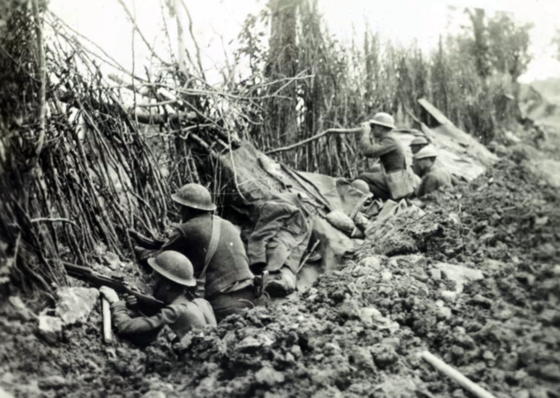
“Pioneered as far back as the late Middle Ages, amusettes, wall guns and rampart guns eventually found their way into the arsenals of most 18th Century European armies.”
LARGER THAN A musket, but not large enough to qualify as artillery, the amusettes of the 18th and 19th centuries certainly packed a wallop.
Also known as ‘wall guns’ or ‘rampart guns,’ these over-sized long-arms were primed, loaded, rammed and fired by a single gunner in much the same way an infantryman would operate a musket. In fact, the chief difference between amusettes and more conventional firearms were the weapons’ size: They were huge! Just how huge? Well, click here to see for yourself.
Pioneered as far back as the late Middle Ages, amusettes, wall guns and rampart guns eventually found their way into the arsenals of most 18th Century European armies, albeit in limited numbers. During the War of Independence, at least one Continental armoury furnished the rebellion with several of the jumbo long arms – both smooth-bore and rifled. Another source shows that they were used by the King’s forces in North America as well. They quickly proved their value on rugged landscapes of the North American frontier, particularly in environments where traditional artillery couldn’t go.
A typical amusette measured up to seven feet from butt to muzzle – more than two feet longer than a British Brown Bess. While standard European and North American muskets varied in caliber from .69 to .75, an amusette fired a much larger ball — sometimes 1.2-inches (30 mm) in diameter. And it fired much farther too. The average smooth-bore long-arm of the era was accurate to about 50 to 100 yards – an amusette’s 60-inch barrel could propel a a lead ball weighing a tenth of a pound or more 10 times as far. And they were accurate too. American general Charles Lee of the Revolutionary War boasted in a letter that practice shots from his newly acquired amusettes had struck paper targets at up to 500 yards. [1] Some fired as far as 1,000 yards.

Yet, the astounding performance of these super guns was offset by the fact that they were heavy. Most weighed in excess of 50 lbs., much more cumbersome than a typical 10-lb. musket. Accordingly, amusettes were usually fitted with a steel swivel on the underside midway down the barrel. This allowed the weapon to be mounted atop a wall, on the rail of a ship or even the bow of a rowboat and then pivoted. Some were even fixed to wheeled trunnions and could be rolled into action like a grasshopper cannon. In other cases, amusettes were deployed forward of an infantry formation along with an army’s skirmishers – almost like an 18th Century version of a light machine gun, as one source characterized it. Rampart guns and the like could be made more portable however by shortening the barrel. In fact, sawed off versions of the weapon were sometimes used by sailors and marines to fire loads of lead shot – an ideal weapon in a naval boarding action.

Amusettes were gradually phased out in most western militaries in the early 19th Century. Yet the concept wasn’t entirely abandoned. Surprisingly, armies in China during the late 19th Century engineered their own rampart guns, known as jingals, to be used in fortifications. Fashioned after modern bolt-action rifles of the day like the Mauser Gewehr model 1888, the enormous weapons could fire outsized rifle rounds (.60 even .75 caliber) tremendous distances with great precision.
Similar weapons were fielded by both the Germans and the Allies during the First World War. Elephant guns popular among hunters and sportsmen in Africa became a favourite of anti-sniper teams on the Western Front. The guns’ large caliber rounds could easily penetrate the thick iron plates many snipers favoured for cover. Later, when tanks made their battlefield debut, Germany developed a monster-sized bolt-action anti-tank rifle, the T-Gewehr 1918. Manufactured by Mauser, the weapon could put a 13.2 mm steel jacketed slug through the armour of a British Mark IV tank from across a battlefield. More than 15,000 were produced before the end of the war.
SOURCES:
http://www.forgottenweapons.com/rifles/chinese-jingal-wall-gun/
http://www.history.army.mil/news/2013/130325a_amusettes.html
http://en.wikipedia.org/wiki/Wall_gun
http://beforeitsnews.com/alternative/2013/01/the-wall-guns-some-epically-large-rifles-2550934.html
http://www.guns.com/2013/01/30/the-wall-guns-some-epically-large-rifles/?utm_source=rss&utm_medium=rss&utm_campaign=the-wall-guns-some-epically-large-rifles
http://ww2.rediscov.com/spring/VFPCGI.exe?IDCFile=/spring/DETAILS.IDC,SPECIFIC=9800,DATABASE=objects,
http://www.jaegerkorps.org/amusette.html
http://www.nam.ac.uk/online-collection/detail.php?acc=1997-05-1-1










Fascinating! Prior to this excellent article, I did not know that Amusettes were used as portable “heavy weapons”, and not merely as Wall or Boat guns.
I then assumed that the kick / recoil from these monster pieces would destroy the shoulder of the gunner. Wrong again! The Hesse Kassel Jaeger link insists that “The mass and barrel length involved in these stocked amusettes really absorb a great deal of recoil, they are not uncomfortable to shoot at all.”
Thank you very much for this highly informative article.
Thanks.
Surprised you did not mention probably the last appearance of one of these “giant” rifles, the British Boys (incorrectly Boyes) anti-tank rifle. Nicknamed the Elephant Gun, not because of its size but because its recoil was likened to being kicked by an elephant. See http://www.rifleman.org.uk/Enfield_Boys_Anti-Tank_Rifle.htm for more information.
That Mauser… Holy crap!! Pierce a Mark IV? Dang…but what damage would it have caused inside if it did pierce?